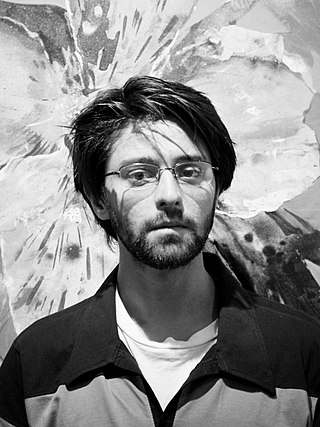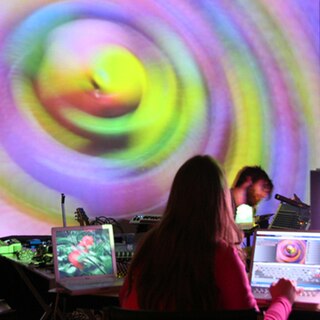Postminimalism is an art term coined by Robert Pincus-Witten in 1971 and used in various artistic fields for work which is influenced by, or attempts to develop and go beyond, the aesthetic of minimalism. The expression is used specifically in relation to music and the visual arts, but can refer to any field using minimalism as a critical reference point. In music, "postminimalism" refers to music following minimal music.
The Boston Cyberarts Festival used to be the largest festival of digital art, performance and film created using new technology in the USA. Around 22,000 people attended the festival in 2007 where they witnessed the work of over 200 artists from all over the world.
Cyberarts or cyberart refers to the class of art produced with the help of computer software and hardware, often with an interactive or multimedia aspect.

Amirali Ghasemi is an Iranian independent curator, media artist, and graphic designer based in Tehran and Berlin. He is the founder and director of Parkingallery, an art space in Tehran that has established itself as an accessible platform for young Iranian contemporary artists. He also founded New Media Society and focuses on his curatorial projects at New Media Society and Tamaas Foundation for Media Arts.

VJing is a broad designation for realtime visual performance. Characteristics of VJing are the creation or manipulation of imagery in realtime through technological mediation and for an audience, in synchronization to music. VJing often takes place at events such as concerts, nightclubs, music festivals and sometimes in combination with other performative arts. This results in a live multimedia performance that can include music, actors and dancers. The term VJing became popular in its association with MTV's Video Jockey but its origins date back to the New York club scene of the 1970s. In both situations VJing is the manipulation or selection of visuals, the same way DJing is a selection and manipulation of audio.

Cabinet Magazine is a quarterly, Brooklyn, New York–based, non-profit art and culture magazine established in 2000. Cabinet Magazine also operates an event and exhibition space in Brooklyn. In 2022, Cabinet transitioned its magazine to be a digital publication, although it still publishes print books.

Cyclic Defrost is an Australian specialist electronic music magazine. It was founded and edited by Sebastian Chan, with current editors Bob Baker Fish, Chris Downton and Peter Hollo. It covers independent electronic music, avant-rock, experimental sound art and left field hip hop.

TJ Norris is an American interdisciplinary artist known for his urban, conceptual photography and installation projects. Hailing from New England, Norris is also a celebrated curator and freelance writer based in Texas.

Launched from the Lower East Side, Manhattan in 1983 as a subscription only bimonthly publication, the Tellus Audio Cassette Magazine utilized the audio cassette medium to distribute no wave downtown music and audio art and was in activity for the ten years of 1983–1993.
The Mobius Artists Group is an interdisciplinary group of artists, founded in 1977 by Marilyn Arsem in Boston, Massachusetts as Mobius Theater. It is known for incorporating a wide range of visual, performing and media arts into live performance, video, installation and intermedia works. The members of the group create projects individually and in collaboration with members of the group and other artists. Mobius, Inc. is an artist-run 501(c)3 non-profit organization for experimental work in all media. From 1983 to 2003, the group ran an alternative art center at 354 Congress Street in Boston, later moved to a space at 725 Harrison Avenue and are currently located across the river at 55 Norfolk Street in Cambridge, MA. Founded by members of the Mobius Artists Group in 1983, the art center is a laboratory for artists experimenting at the boundaries of their disciplines.
The Museum of Bad Art (MOBA) is a privately owned museum whose stated aim is "to celebrate the labor of artists whose work would be displayed and appreciated in no other forum". It was originally in Dedham, Massachusetts, and is currently in Boston, Massachusetts. Its permanent collection includes over 700 pieces of "art too bad to be ignored", 25 to 35 of which are on public display at any one time.
Afterall is a nonprofit contemporary art research and publishing organisation. It is based in London, at Central St Martins College of Art & Design. It publishes the journal Afterall; the book series Readers,One Works and Exhibition Histories.

CyberArts International was a series of conferences dealing with emerging technologies that took place during years 1990, 1991, and 1992 in Los Angeles and Pasadena, California. The gatherings brought together artists and developers in all types of new media, including software engineers, electronic musicians, and graphic artists to explore what was a new field at the time, digital media collaborations.

Anna Banana is a Canadian artist known for her performance art, writing, and work as a small press publisher. She has been described as an "entrepreneur and critic", and pioneered the artistamp, a postage-stamp-sized medium. She has been prominent in the mail art movement since the early 1970s, acting as a bridge between the movement's early history and its second generation. As a publisher, Banana launched Vile magazine and the "Banana Rag" newsletter; the latter became Artistamp News in 1996.

Ars Electronica Linz GmbH is an Austrian cultural, educational and scientific institute active in the field of new media art, founded in Linz in 1979. It is based at the Ars Electronica Center (AEC), which houses the Museum of the Future, in the city of Linz. Ars Electronica's activities focus on the interlinkages between art, technology and society. It runs an annual festival, and manages a multidisciplinary media arts R&D facility known as the Futurelab. It also confers the Prix Ars Electronica awards.
The conservation and restoration of time-based media art is the practice of preserving time-based works of art. Preserving time-based media is a complex undertaking within the field of conservation that requires an understanding of both physical and digital conservation methods. It is the job of the conservator to evaluate possible changes made to the artwork over time. These changes could include short, medium, and long-term effects caused by the environment, exhibition-design, technicians, preferences, or technological development. The approach to each work is determined through various conservation and preservation strategies, continuous education and training, and resources available from institutions and organization across the globe.
Kathy Rae Huffman is an American curator, writer, producer, researcher, lecturer and expert for video and media art. Since the early 1980s, Huffman is said to have helped establish video and new media art, online and interactive art, installation and performance art in the visual arts world. She has curated, written about, and coordinated events for numerous international art institutes, consulted and juried for festivals and alternative arts organisations. Huffman not only introduced video and digital computer art to museum exhibitions, she also pioneered tirelessly to bring television channels and video artists together, in order to show video artworks on TV. From the early 1990s until 2014, Huffman was based in Europe, and embraced early net art and interactive online environments, a curatorial practice that continues. In 1997, she co-founded the Faces mailing list and online community for women working with art, gender and technology. Till today, Huffman is working in the US, in Canada and in Europe.
The conservation and restoration of performance art is the process of documenting, collecting, and prolonging the life of Performance Art. Performance Art often features a live presentation initially documented by an artist, cultural institution, or host location. This genre of art can take place in a wide range of mediums, and is usually based on four core elements: Time, Space, the Performer's body, and the relationship between viewers and performer. These variables determine how it can be collected and conserved within museums or cultural institutions.

Mizna is a nonprofit arts organization in St. Paul, Minnesota. Founded in 1999, Mizna describes itself as "a critical platform for Arab and Southwest Asian and North African (SWANA) film, literature, and art." Since 1999, Mizna has published a biannual literary journal, Mizna: SWANA Literature + Art. Since 2003, Mizna has produced the Twin Cities Arab Film Festival (TCAFF), which became annual in 2013. Throughout its history, Mizna has organized and participated in a variety of arts and cultural programming, including visual art exhibitions, community workshops, drumming and Arabic classes, and local festivals such as Northern Spark. In 2020, Mizna was named Best Nonprofit by City Pages.










